2017年中考英语语法大全:介词
初中英语中考语法复习介词知识点

中考英语语法复习介词知识点1.简单介词in on with by for at about under of to at until from before after during above under2.合成介词into within inside outside without throughout3.短语介词according to, because of,in front of,in spite of4.时间介词at、on、in、before、after、during、from、about、by、until5.地点介词in、on、under、at、above、behind、before6.介词用法年月周前要用 in,日子前面却不行。
遇到几号要用"on",上午下午又是"in"要说某日上下午,用 on 换 in 才能行。
午夜黄昏用 at,黎明用它也不错。
at 也在时分前,说"差"用 to,说"过"要用past。
用in:年、月、季节、周、阳光、灯、影、衣、冒(雨)用in;将来时态in表后;小处at,大处in;语言、单位、材料in。
用on:步行、驴、马、玩笑on用at:山脚、门口、在当前,速、温、日落、价、核心用with:具有、工具、和、同随有形with无形by;(with后加工具,工具是有形的;by后加方式,方式是无形的)7.动词+介词常用短语About的短语think about 考虑bring about 导致;引起care about 关心;在意dream about 梦想;梦见hear about 听说hang about 闲逛learn about 了解know about 知道;了解look about 环顾;四处看talk about 谈论;议论worry about 担心write about 编写;写作At的短语arrive at 到达knock at 敲laugh at 嘲笑look at 看point at 指向shout at 朝……大喊smile at 对……微笑throw at 朝……扔Away的短语put away 储存;放好keep sb./sth. away (使)避开;(使)不靠近blow away 吹走,驱散stay away from 与……保持距离;远离give away 赠送get away 逃离move away 搬走go away 离开run away 逃跑,跑掉pass away 去世throw away 扔掉take away 拿走;带走wash away 冲走walk away 起开,离去Back的短语bring back 恢复;使想起;归还give back 归还call(sb.) back 给(某人)回电话go back 回去come back 回来;再度流行pay back 偿还(借款等)get back 回来;返回;回家Down的短语write down 写下;记下take down 拆掉;取下;记下1break down 停止运转;(机器等)出故障turn down 把调低;关小;拒绝calm down 冷静下来cut down 砍倒;缩减die down 减弱;逐渐平息fall down 倒塌;跌倒lie down 躺下pull down 拆除;摧毁put down 放下;记下sit down 坐下slow down (使)减速;(使)放松For的短语search for 搜索;查找thanks for 因……而感激die for 为而死care for 照顾;关怀look for 寻找leave for 动身去pay for 为……付钱stand for 代表prepare for 为……做准备wait for 等待Off的短语burn off 燃烧turn off 关掉cut off 切断;中断break off 突然中止;中断give off 散发;释放get off 下车keep off (使)不接近;远离go off 熄灭;响起put off 推迟;拖延pay off 还清(欠款);成功see off 送行run off 跑掉;逃跑show off 炫耀;显摆set off 动身;启程;使爆炸take off 脱下衣服;(飞机等)起飞shut off 关闭;停止运转On的短语hold on 等一等(别挂电话)pass on 传递keep on 继续(进行)try on 试穿take on 承担;呈现work on 从事;忙于agree on 对意见……一致come on 加油carry on 继续call on 访问;拜访depend on 依靠;依赖;视……而定;取决于decide on 决定;选定get on 上车;进展go on 继续live/feed on 以……为食;靠……谋生put on 穿上;增重;上演turn on 打开Up的短语drive up 开车end up 最终;结束;到头来fill up 装满;填补fix up 修理give up 放弃make up 编造;化妆pick up 接(某人);捡起look up 查阅;查找set up 建立;创立;建造show up 出席;露面take up 开始做;从事;占据stay up 不睡觉;熬夜turn up 调高(音量);出现wake up 睡醒;醒来bring up 养育;提出grow up 成长;长大cheer up 使……振奋;hurry up 赶紧clean up 把(……)打扫干净;put up 张贴;举起;搭建cut up 切碎stand up 站起来dress up 穿上盛装;装扮With的短语deal with 处理;应付play with 和……玩耍agree with 赞同;持相同意见catch up with 赶上(或超过)begin/start with 以……开始come up with 提出;想出(主意、回答等)communicate with 和……交流end up with 以……结束connect with 与……联系talk with 和……交谈part with 放弃;舍弃(尤其不舍得的东西);与……分开get along with 和……相处2。
初中语法大全讲解--介词
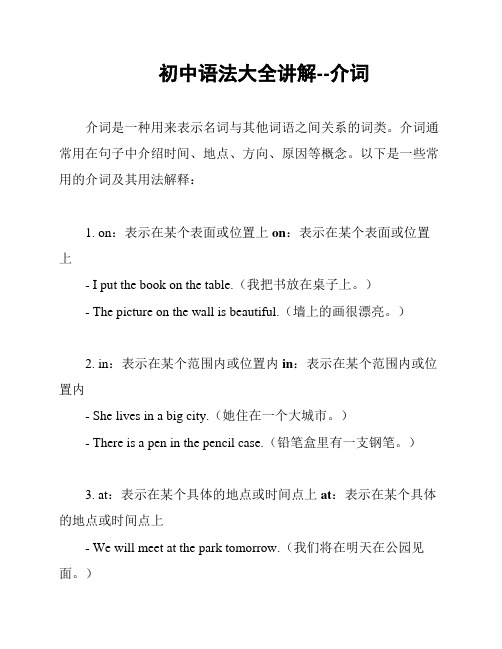
初中语法大全讲解--介词介词是一种用来表示名词与其他词语之间关系的词类。
介词通常用在句子中介绍时间、地点、方向、原因等概念。
以下是一些常用的介词及其用法解释:1. on:表示在某个表面或位置上on:表示在某个表面或位置上- I put the book on the table.(我把书放在桌子上。
)- The picture on the wall is beautiful.(墙上的画很漂亮。
)2. in:表示在某个范围内或位置内in:表示在某个范围内或位置内- She lives in a big city.(她住在一个大城市。
)- There is a pen in the pencil case.(铅笔盒里有一支钢笔。
)3. at:表示在某个具体的地点或时间点上at:表示在某个具体的地点或时间点上- We will meet at the park tomorrow.(我们将在明天在公园见面。
)- He is waiting for you at the front door.(他在门口等你。
)4. to:表示朝向某个目标或对象to:表示朝向某个目标或对象- She walked to school.(她走向学校。
)- Can you pass the book to me?(你能把书递给我吗?)5. with:表示伴随或使用某个工具或对象with:表示伴随或使用某个工具或对象- I went to the park with my friends.(我和我的朋友一起去了公园。
)- He wrote the letter with a pen.(他用钢笔写了这封信。
)6. by:表示通过某种方式或交通工具by:表示通过某种方式或交通工具- We usually go to school by bus.(我们通常坐公交车去学校。
)- She sent the gift by mail.(她通过邮寄发送了礼物。
介词英语大全
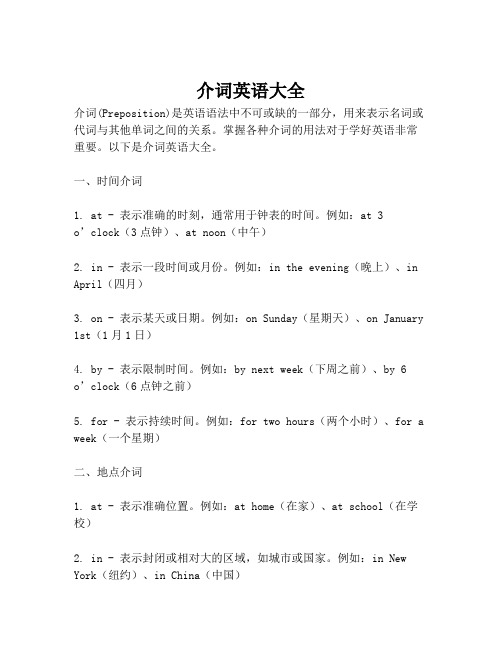
介词英语大全介词(Preposition)是英语语法中不可或缺的一部分,用来表示名词或代词与其他单词之间的关系。
掌握各种介词的用法对于学好英语非常重要。
以下是介词英语大全。
一、时间介词1. at - 表示准确的时刻,通常用于钟表的时间。
例如:at 3o’clock(3点钟)、at noon(中午)2. in - 表示一段时间或月份。
例如:in the evening(晚上)、in April(四月)3. on - 表示某天或日期。
例如:on Sunday(星期天)、on January 1st(1月1日)4. by - 表示限制时间。
例如:by next week(下周之前)、by 6 o’clock(6点钟之前)5. for - 表示持续时间。
例如:for two hours(两个小时)、for a week(一个星期)二、地点介词1. at - 表示准确位置。
例如:at home(在家)、at school(在学校)2. in - 表示封闭或相对大的区域,如城市或国家。
例如:in New York(纽约)、in China(中国)3. on - 表示在物体上面。
例如:on the table(在桌子上)、on the wall(在墙上)4. under - 表示在物体下面。
例如:under the bed(床底下)、under the tree(树下)5. over - 表示在物体上方。
例如:over the bridge(桥上)、over the sky(天上)6. behind - 表示在物体后面。
例如:behind the door(门后)、behind the curtain(帘后)7. in front of - 表示在物体前面。
例如:in front of the house (房子前面)、in front of the mirror(镜子前面)8. at the back of - 表示在物体后面。
中考英语常用介词用法和固定搭配总结

中考英语常用介词用法和固定搭配总结常用介词用法和固定搭配总结:1. in –在一些位置或状态:in the park, in a hurry固定搭配:in front of, in the middle of, in the end2. on –表示在一些表面或接触点上:on the table, on the wall固定搭配:on foot, on the way, on duty3. at –在一些具体位置或时间点:at school, at 9 o'clock5. for –表示目的、目标或对象:study for the test, apresent for you固定搭配:wait for, thank you for, look for7. with –表示伴随、具备其中一种特征:go out with friends,a girl with long hair固定搭配:a conversation with, agree with, help with8. by –表示通过、凭借其中一种方式或手段:go to school by bus, learn by doing固定搭配:by the way, by accident, by oneself9. about –关于其中一主题、内容或事情:talk about the movie,a book about history固定搭配:think about, worry about, care about10. for –表示计划或安排事:get ready for the exam, prepare for a trip固定搭配:study for, wait for, ask for11. with –用于描述其中一种状态或情况:be happy with the result, be busy with work固定搭配:satisfied with, familiar with, pleased with12. about –表示具体细节或内容:talk about your trip, a movie about love固定搭配:worry about, think about, care about这些是常用的英语介词用法和一些固定搭配,但在实际运用中还需根据具体语境选择合适的介词。
初中英语语法专题—介词讲解
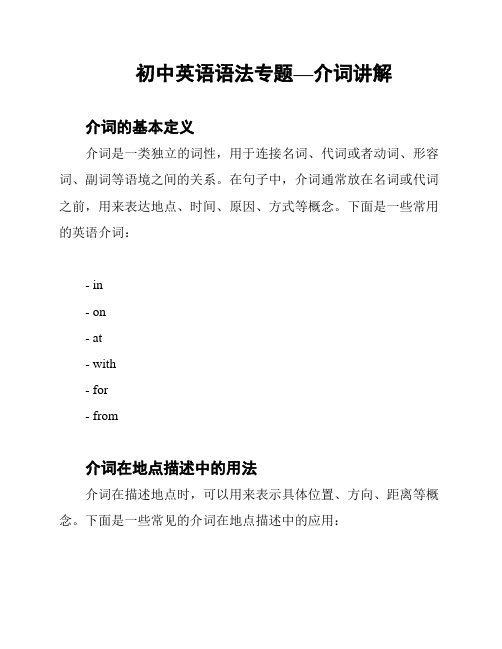
初中英语语法专题—介词讲解介词的基本定义介词是一类独立的词性,用于连接名词、代词或者动词、形容词、副词等语境之间的关系。
在句子中,介词通常放在名词或代词之前,用来表达地点、时间、原因、方式等概念。
下面是一些常用的英语介词:- in- on- at- with- for- from介词在地点描述中的用法介词在描述地点时,可以用来表示具体位置、方向、距离等概念。
下面是一些常见的介词在地点描述中的应用:- in:用于表示在某个范围之内的位置,例如 "in the room"(在房间里),"in the park"(在公园里)。
- on:用于表示在表面、平台或者位置上的状态,例如 "on the table"(在桌子上),"on the bus"(在公交车上)。
- at:用于表示在某个具体位置或者地点,例如 "at the cinema"(在电影院),"at school"(在学校)。
- to:用于表示朝向某个位置的移动,例如 "go to the park"(去公园)。
介词在时间描述中的用法介词在描述时间时,可以用来表示具体时间、时间段等概念。
下面是一些常见的介词在时间描述中的应用:- at:用于表示具体的时间点,例如 "at 7 o'clock"(在7点钟)。
- on:用于表示具体的日期或者星期几,例如 "on Monday"(星期一),"on January 1st"(1月1日)。
- in:用于表示较长的时间段或者某一个时间段内,例如 "inthe morning"(早上),"in July"(在七月)。
介词在原因描述中的用法介词在描述原因时,可以用来表示某事的起因或者原因。
2017年中考英语语法大全:介词

I介词的功能 介词是⼀种虚词,⽤来表⽰名词或相当于名词的其它词语句中其它词的关系,不能单独使⽤。
介词可与名词或相当于名词的其它词构成介词短语。
介词短语可在句中作定语,状语,表语和宾语补⾜语。
例如: The boy over there is John’s brother. (定语) The girl will be back in two hours. (状语) Our English teacher is from Australia. (表语) Help yourself to some fish. (宾语补⾜语) II表⽰时间的介词 表⽰“时间”的介词如下: 1.表⽰年、⽉、⽇、时刻等⽤at,in,on 2.表⽰时间的前后⽤ before, after 3.表⽰期限等⽤by,until,till 4.表⽰期间等⽤for,during,through 5.表⽰时间的起点等⽤ from, since 6.表⽰时间的经过等⽤in,within (1) at,on,in 1)at:⽤于表⽰时刻、时间的某⼀点 at noon正午时 at night在夜间 at present⽬前 at nine(o’clock)在九点钟 We usually have lunch at noon(at twelve). 我们通常中午吃午饭(⼗⼆点吃午饭)。
(2)on:⽤于某天,某⼀天的上、下午(指具体的某⼀天时,⼀律⽤on) 注意 : 泛指⼀般的上午(下午)时⽤in,但特指某⽇的上午(下午)时⽤on。
in the morning在早上 on sun day morning在周⽇早上 on Monday在周⼀ on Tuesday morning在周⼆早上 on June 6在6⽉6⽇ on May 4,1996在1996年5⽉4⽇ on a cold night在⼀个寒冷的夜晚 on the night of July(the) first 在七⽉⼀⽇的夜晚 We didn't listen to the lecture on Wednesday afternoon 上周三下午我们没去听演讲。
初中英语介词用法总结
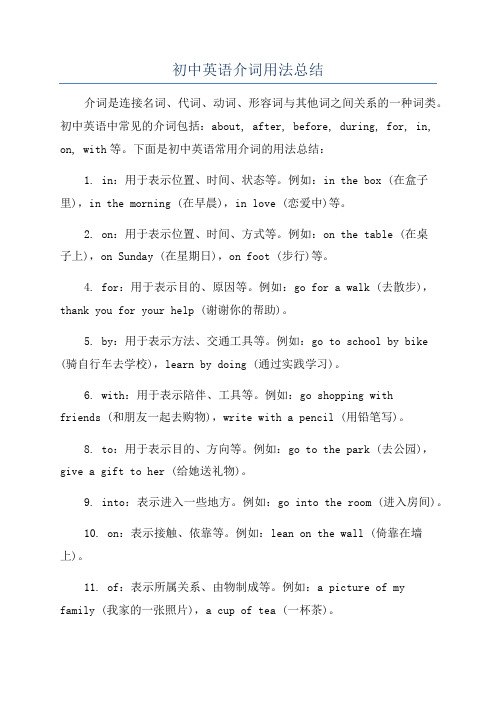
初中英语介词用法总结介词是连接名词、代词、动词、形容词与其他词之间关系的一种词类。
初中英语中常见的介词包括:about, after, before, during, for, in, on, with等。
下面是初中英语常用介词的用法总结:1. in:用于表示位置、时间、状态等。
例如:in the box (在盒子里),in the morning (在早晨),in love (恋爱中)等。
2. on:用于表示位置、时间、方式等。
例如:on the table (在桌子上),on Sunday (在星期日),on foot (步行)等。
4. for:用于表示目的、原因等。
例如:go for a walk (去散步),thank you for your help (谢谢你的帮助)。
5. by:用于表示方法、交通工具等。
例如:go to school by bike (骑自行车去学校),learn by doing (通过实践学习)。
6. with:用于表示陪伴、工具等。
例如:go shopping withfriends (和朋友一起去购物),write with a pencil (用铅笔写)。
8. to:用于表示目的、方向等。
例如:go to the park (去公园),give a gift to her (给她送礼物)。
9. into:表示进入一些地方。
例如:go into the room (进入房间)。
10. on:表示接触、依靠等。
例如:lean on the wall (倚靠在墙上)。
11. of:表示所属关系、由物制成等。
例如:a picture of myfamily (我家的一张照片),a cup of tea (一杯茶)。
12. with:表示伴随、具有。
例如:a girl with long hair (一个长发的女孩),a book with pictures (一本有图片的书)。
英语介词知识点归纳
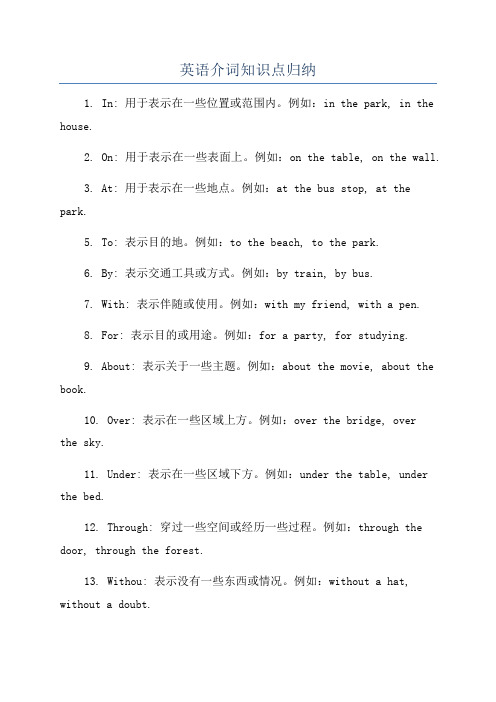
英语介词知识点归纳1. In: 用于表示在一些位置或范围内。
例如:in the park, in the house.2. On: 用于表示在一些表面上。
例如:on the table, on the wall.3. At: 用于表示在一些地点。
例如:at the bus stop, at the park.5. To: 表示目的地。
例如:to the beach, to the park.6. By: 表示交通工具或方式。
例如:by train, by bus.7. With: 表示伴随或使用。
例如:with my friend, with a pen.8. For: 表示目的或用途。
例如:for a party, for studying.9. About: 表示关于一些主题。
例如:about the movie, about the book.10. Over: 表示在一些区域上方。
例如:over the bridge, overthe sky.11. Under: 表示在一些区域下方。
例如:under the table, under the bed.12. Through: 穿过一些空间或经历一些过程。
例如:through the door, through the forest.13. Withou: 表示没有一些东西或情况。
例如:without a hat, without a doubt.14. Above: 表示在物之上。
例如:above the clouds, above the sign.15. Below: 表示在物之下。
例如:below the surface, below the line.。
中考英语常用介词知识点总结

中考英语常用介词知识点总结一.表示时间的介词1. in, on, at在……(之时)①in与年、季节、月、年代、世纪及一般(泛指)的早、中、晚等较长时间的词连用eg:in summer在夏天;in January在1月;in 2012 在2012年;in the morning在早上in the 21st century②on用于具体的某日或某特定日期的早、中、晚。
如:on August 8th在8月8日;on Monday在星期一;on New Year’s Day;on a cold morning在一个寒冷的早晨;on Sunday afternoon在星期天下午。
③at表示某一时刻。
如:at 5∶10pm 在下午5∶10;at the beginning of在开始时;at the end of...在……的末尾;at the age of...在……岁时;at noon在中午;at the same time在同时。
at night在晚上;2. in, after 在……之后“in +时间段”用于将来时之中;“after+时间段”用于过去时态之中;“after+时间点”既可用于将来时也可用于过去时。
如:Jim will go to Beijing in five days.吉姆五天后会去北京。
Jim went to Beijing after five days.五天后,吉姆去了北京。
Jim will go to Beijing after five o’clock.吉姆会在五点钟后去北京。
3. for, sincefor可以指过去、现在或将来,着重说明“多久”,后面接时间段。
since意为“自从……起”,多与完成时连用,后面接时间点或从句。
since引导的从句通常为一般过去时。
如:He has lived here for 2 weeks./ He has lived here since 2 weeks ago.It’s five years since he left school.4. after, behind 在……之后after主要用于表示时间;behind主要用于表示位置。
2017年中考英语语法专题详解三

介词、连词 ⼀. 介词 1. 介词概述:介词表⽰它与后⾯的名词或代词与其他句⼦成分的关系。
介词是虚词,不能单独做句⼦成分。
介词在英语中⽤法很活,也⽆⼀定规律可循。
在初中范围内还应学⼀个记住⼀个,特别是那些和动词的特殊搭配。
2. 常⽤介词的意义和⽤法。
⑴时间或地点介词in、on、at的⽤法区别: 表⽰时间时, in表⽰在⼀段时间⾥(在将来时句⼦中则表⽰在⼀段时间之后), on表⽰在具体的某⼀天或者某天的上下午等, at 表⽰在某个时刻或者瞬间; 表⽰地点时, in表⽰在某个范围之内, on表⽰在某个平⾯上或与⼀个⾯相接触,at则表⽰在某个具体的场所或地点。
如: He was born on the night of May 10th. I usually get up at 7:00 in the morning. His glasses are on the desk. My brother is at the bus stop. ⑵ after与in表⽰时间的⽤法区别:“after+(具体时刻/从句)”表⽰“在…时刻之后”常⽤于⼀般过去时态;“in+(⼀段时间)”表⽰“在(多久)之后”,常⽤于将来时态。
如: He said that he would come back after 6:00. My father is coming back from Astralia in about a month. ⑶ since与for表⽰时间的⽤法区别:“since+(具体时刻/that-从句)”表⽰“⾃从…起⼀直到现在”,“for +(⼀段时间)”表⽰“持续⼀段时间”,都常⽤于完成时态;如: My father has worked in this factory since 1970. My father has worked in this factory for over 30 years. ⑷ by、in与with表⽰⽅式的⽤法区别:都可以表⽰“⼯具、⼿段”,但是by主要表⽰“乘坐”某个交通⼯具或“以……⽅式”,在被动句中可以表⽰动作的执⾏者;in表⽰“使⽤”某种语⾔/⽂字,with表⽰“使⽤”某个具体的⼯具、⼿段。
中考英语语法讲解之介词和介词短语

介词和介词短语1、介词的主要用法:介词是一种虚词,不能独立使用。
介词之后一般有名词或代词(宾格..)或相当于名词的其他词类、短语或从句作它的宾语,即构成介词短语。
有些介词是由两个以上的词构成的短语介词,如:out of(从…中出来), because of(因为), away from(距离…), on top of(在…顶上), ever since(自从…), next to(在…隔壁), according to(根据…), in front of(在…前方)等。
2)above在…前, about在…附近, across在…对面, after在…后面, against倚着..., along在…近旁, among周围, round在….周围, at在…处, before在...前, behind在...后, below低于..., beside在...旁边, between在...之间, by在...旁, down在...下面, from来自..., in在...里面, inside在...里面, near靠近..., of在...之中, on在...上面, out of在...之外, outside在....外面, over在....上方, under在...下方, up在...上面, on top of在...顶部, in front of在...前,在...的中间, at the end of在...的末端,等等。
across横越..., against对抗..., along沿着..., around绕着..., round环绕..., at朝着..., behind向…后面,...,by路过/通过..., down向…下, for向..., from从/离..., in进入..., into进入..., inside到...里面, near接近..., off脱离/除..., on向...上, out of向...外, outside向....外, over跨过..., past经过/超过..., through穿过..., to向/朝..., towards 到...上面, onto到...上面, up向...上, away from远离...about大约..., after在…以后, at在… (时刻), before在…以前, by到…为止, during在…期间, for有…(之久), from, in在(上/下午);在(多久)以后, on在(某日), past过了…(时), since自从…(至今), through 贯穿…(期间), till直到…时, until直到…时, to到(下一时刻), ever since从那时起至今,at the beginning of在...开始时,at the end of在...末, in 在...当中,at the time of在...时as作为/当作..., by用/由/乘坐/被..., in用…(语言), like与…一样, on骑(车)/徒(步),通过(收音机/电视机), over), through通过..., with用(材料),用(手/脚/耳/眼), without没有…about关于..., except除了…, besides除了…还... for对于/就…而言, in在…(方面), of…的,有关..., on关于/有关...,, towards针对..., with就…而言其它介词:【目的介词】for为了..., from防止…,to为了…【原因介词】for因为..., with由于…, because of因为...【比较介词】as与…一样,like象…一样,than比...,to与…相比, unlike与…不同【伴随/状态介词】against和…一起(比赛),at在(上班/休息/上学/家,etc.),in穿着…(衣服/颜色),into变成...,on在(值日), with与…一起,有/带着/长着..., without没有/无/不与…一起3、介词短语的句法作用:介词短语相当于一个形容词或副词,可用作状语、定语和表语。
中考介词归纳总结

中考介词归纳总结在中考中,介词是一个非常重要且常考的语法知识点。
介词在句子中起连接作用,表达时间、地点、方式、原因等关系。
掌握介词用法对于理解和运用英语至关重要。
本文将对中考所涵盖的常见介词进行归纳总结。
一、时间介词1. on:表示某一天或某一天的上午、下午、晚上等特定时间。
例:I will have a meeting on Monday.2. at:表示具体的时间点或特定的时刻。
例:We will meet at 9 o'clock.3. in:表示某一年、月、季节、时间段等。
例:She was born in 2005.例:We usually go swimming in summer.4. during:表示在某一段时间内。
例:He read a book during his summer vacation.二、地点介词1. at:表示具体的地点。
例:She is waiting for you at the bus station.2. on:表示表面或某物之上。
例:There is a book on the table.3. in:表示在某个范围、区域、国家或大洲内。
例:We live in a small town.4. to:表示朝向、方向。
例:He went to the library.三、方式介词1. by:表示通过某种交通方式或手段。
例:I usually go to school by bus.2. with:表示伴随、陪同。
例:She walks to school with her friends.3. in:表示用某种方式或手段。
例:He communicated with her in English.四、原因介词1. for:表示目的、原因或理由。
例:He went to the store for some milk.2. because of:表示因为。
中考英语语法介词和介词短语

to finish the task?
—Say, A.before C.for
two hours. B.at D.in
6.(2018·四川内江中考)The accident took place
a
cold November evening.
A.on
B.in
C.at
D.for
7.(2018·江苏南京中考)Neil Armstrong was the first man to
five
children. A.include C.included
B.including D.includes
考点五 介词短语 a bit (of)有一点儿 after a while过了一会儿 a little一点儿 all kinds of 各种类型的;各种各样的 a lot of许多
a pair of 一双 a set of 一套;一副;一组 around the world 世界各地 as long as只要;既然 at first起先;首先 at last最后 at least至少;不少于;起码
3.for, since for和since表示的时间状语都有延续之意,“for+时间段” 表示“延续多久”,作时间状语时,句子可用过去时、完成 时或将来时;since后接表示时间点的短语,意为“自从(过 去某时)以来”,说明自过去某时延续至今的一段时间,常 与完成时连用。
4.in, after in和after后都可以接时间段,表示“……(时间)之后”,in 用于将来时,after用于过去时。
played. A.in C.on
B.at D.of
4.(2018·安徽蚌埠禹会二模改编)Mr. Brown arrived at the
中考英语介词用法归纳总结

中考英语介词用法归纳总结1.在表示位置的介词:- in:用于表示在一些具体的地点或位置内,如in the bedroom (在卧室里)、in the park(在公园里)。
- at:用于表示在一些具体的地点或位置上,如at the bus stop (在公交车站)、at the table(在桌子旁边)。
- on:用于表示在一些具体的平面或表面上,如on the ground(在地上)、on the desk(在桌子上)。
- under:用于表示在一些物体的下方,如under the tree(在树下)、under the bed(在床底下)。
- over:用于表示在一些物体的上方,如over the bridge(在桥上)、over the head(在头顶上)。
2.在表示时间的介词:- at:用于表示具体的时间点,如at 8 o'clock(在8点)、at noon(在中午)。
- in:用于表示较长的时间段,如in the morning(在上午)、in June(在6月份)。
- on:用于表示具体的其中一天,如on Sunday(在周日)、on New Year's Day(在元旦)。
- during:用于表示在一些时间段内,如during the summer vacation(在暑假期间)。
3.在表示目的的介词:- for:用于表示为了一些目的,如study hard for the exam(为了考试而努力学习)。
- to:用于表示给人或物,如give a present to my friend(给我朋友送礼物)。
4.在表示原因的介词:- because of:用于表示因为一些原因,如because of the heavy rain(因为大雨)。
- due to:用于表示由于一些原因,如the delay is due to the bad weather(延误是因为坏天气)。
中考英语语法大全——介词和介词短语

中考英语语法大全——介词和介词短语一、介词的定义介词又叫前置词,在句子中不能单独使用,总是与其后面的名词、代词或相当于名词的词一起构成介词短语,表达多种不同的意义。
介词具有以上3大特点:1.介词后面的词作介词的宾语,被称作介词宾语。
2.介词后面的代词需用宾格形式。
3.介词后面的动词要用动名词形式。
二、介词的分类介词按照构成形式可以分为四种。
(1)简单介词简单介词是指由一个单词构成的介词。
如:about,above,after,at,between,before,by,for,from,like,in,of 等。
Can you come to my party on Saturday afternoon?(2)合成介词合成介词是指由两个单词合在一起构成的介词。
如:inside,into,throughout,upon,within,without等。
I don’t know what I’d do without you.(3)双重介词词双重介词是指由两个介词搭配在一起构成的介词。
如:except for, from behind, up until等。
Her house is good except for the door.(4)短语介词短语介词是指两个或两个以上的词组合构成的介词,在意义和作用上相当于一个简单的介词。
如:according to, at the end of, in front of等。
Because of the bad weather, we couldn’t see anything below.介词根据其意义可分为表示时间的介词、表示方位空间的介词、表示其他意义的介词。
(1)表示时间的介词常用的有:(2)表示方位空间的介词常用的有:(3)表示其他意义的介词常用的有:三、介词的位置1.介词在句中的通常位置在句子中介词一般放在名词(或代词宾格)之前。
In summer, we often slept under the stars.2.介词在句中的其他位置(1)介词的宾语为疑问词时,介词可以根据情况置于句首或句末。
2017中考英语语法复习:介词
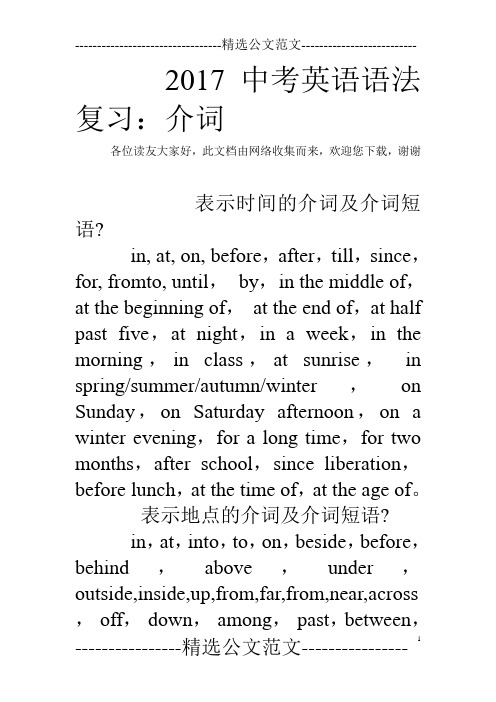
2017中考英语语法复习:介词各位读友大家好,此文档由网络收集而来,欢迎您下载,谢谢表示时间的介词及介词短语?in, at, on, before,after,till,since,for, fromto, until,by,in the middle of,at the beginning of,at the end of,at half past five,at night,in a week,in the morning,in class,at sunrise,in spring/summer/autumn/winter,on Sunday,on Saturday afternoon,on a winter evening,for a long time,for two months,after school,since liberation,before lunch,at the time of,at the age of。
表示地点的介词及介词短语?in,at,into,to,on,beside,before,behind,above,under,outside,inside,up,from,far,from,near,across ,off,down,among,past,between,out of,around,in the front of,in the middle of,at the back of,at the foot of,at home,at the gate,at the table,in the sky,on the ground,in a tree,in the south,in the sun,in the bed,on one’s way home,by the side of。
各位读友大家好,此文档由网络收集而来,欢迎您下载,谢谢。
英语介词讲解

英语介词讲解介词(preposition)是一种用来连接名词、代词或名词短语与其他词或短语的词类,在句子中常常表示位置、方向、时间、关系等。
以下是一些常见的英语介词及其用法:1.in:表示在某个位置、地点、范围或状态之内。
例如:in the room(在房间里)、in London(在伦敦)、in the book(在书中)等。
2.on:表示在某个平面、表面、方向或日期上。
例如:on the table(在桌子上)、on the wall(在墙上)、on Monday(在星期一)等。
3.at:表示在某个点、时间、活动或事件上。
例如:at the park(在公园)、at 8 o'clock(在8点)、at the party(在聚会上)等。
4.by:表示通过某种方式、手段或时间。
例如:by car(乘车)、by email (通过电子邮件)、by Friday(到星期五)等。
5.for:表示为某个目的、目标或时间段。
例如:for you(为你)、for two hours(两个小时)、for breakfast(作为早餐)等。
6.to:表示朝向某个地点、目的地或对象。
例如:to the park(到公园)、to the store(到商店)、to you(给你)等。
7.from:表示起点、来源或运动方向。
例如:from the house(从房子里)、from London(从伦敦)、from Monday to Friday(从星期一到星期五)等。
8.with:表示伴随、附带或使用某物。
例如:with my friend(和我的朋友一起)、with a pen(用一支笔)、with pleasure(乐意)等。
9.about:表示关于某个主题、话题或方面。
例如:about the book(关于这本书)、about the weather(关于天气)、talk about(谈论)等。
10.of:表示属于、关于或由某物组成。
中考英语语法之介词与连词应用
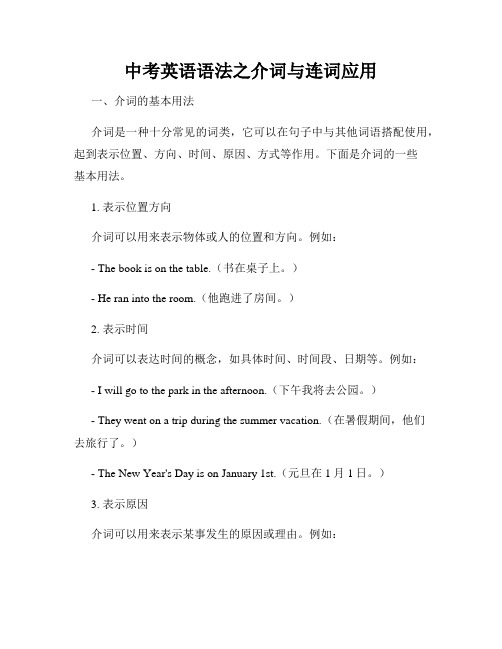
中考英语语法之介词与连词应用一、介词的基本用法介词是一种十分常见的词类,它可以在句子中与其他词语搭配使用,起到表示位置、方向、时间、原因、方式等作用。
下面是介词的一些基本用法。
1. 表示位置方向介词可以用来表示物体或人的位置和方向。
例如:- The book is on the table.(书在桌子上。
)- He ran into the room.(他跑进了房间。
)2. 表示时间介词可以表达时间的概念,如具体时间、时间段、日期等。
例如:- I will go to the park in the afternoon.(下午我将去公园。
)- They went on a trip during the summer vacation.(在暑假期间,他们去旅行了。
)- The New Year's Day is on January 1st.(元旦在1月1日。
)3. 表示原因介词可以用来表示某事发生的原因或理由。
例如:- She failed the exam because of her laziness.(她考试不及格是因为懒惰。
)- He apologized to me for his mistake.(他因为错误向我道歉。
)4. 表示方式介词可以表达某种行为或方式。
例如:- She sings with joy.(她带着喜悦地唱歌。
)- He solved the problem by thinking carefully.(他通过仔细思考解决了这个问题。
)二、连词的基本用法连词是用来连接各种词组、短语或句子的词类,使得语言表达更加流畅和连贯。
下面是连词的一些基本用法。
1. 表示并列关系连词可以把两个或更多的相同类型的词、短语或句子连接起来,表示并列关系。
常见的连词有and、but、or等。
例如:- I like apples and oranges.(我喜欢苹果和橙子。
)- She is smart but lazy.(她聪明但是懒惰。
- 1、下载文档前请自行甄别文档内容的完整性,平台不提供额外的编辑、内容补充、找答案等附加服务。
- 2、"仅部分预览"的文档,不可在线预览部分如存在完整性等问题,可反馈申请退款(可完整预览的文档不适用该条件!)。
- 3、如文档侵犯您的权益,请联系客服反馈,我们会尽快为您处理(人工客服工作时间:9:00-18:30)。
2017年中考英语语法大全:介词I介词的功能介词是一种虚词,用来表示名词或相当于名词的其它词语句中其它词的关系,不能单独使用。
介词可与名词或相当于名词的其它词构成介词短语。
介词短语可在句中作定语,状语,表语和宾语补足语。
例如:The boy over there is John’s brother. (定语)The girl will be back in two hours. (状语)Our English teacher is from Australia. (表语)Help yourself to some fish. (宾语补足语)II表示时间的介词表示“时间”的介词如下:1.表示年、月、日、时刻等用at,in,on2.表示时间的前后用 before, after3.表示期限等用by,until,till4.表示期间等用for,during,through5.表示时间的起点等用 from, since6.表示时间的经过等用in,within(1) at,on,in1)at:用于表示时刻、时间的某一点at noon正午时 at night在夜间 at present目前at nine(o’clock)在九点钟We usually have lunch at noon(at twelve).我们通常中午吃午饭(十二点吃午饭)。
(2)on:用于某天,某一天的上、下午(指具体的某一天时,一律用on)注意 :泛指一般的上午(下午)时用in,但特指某日的上午(下午)时用on。
in the morning在早上on sun day morning在周日早上on Monday在周一on Tuesday morning在周二早上on June 6在6月6日on May 4,1996在1996年5月4日on a cold night在一个寒冷的夜晚on the night of July(the) first在七月一日的夜晚We didn't listen to the lecture on Wednesday afternoon上周三下午我们没去听演讲。
(3)in:用于表示周、月、季节、年,泛指的上午、下午、晚上。
注意:在this,last,next,every等词前面不能再加介词。
this morning今天上午last Friday 上周五 next Sunday下周日every Monday(week, spring…)每周一(每星期,每个春季……)in the week在这周 in May在五月 in spring在春季in 1995在1995年 in September,1995在1995年9月in the morning在上午 in the afternoon在下午in the evening在晚上People go skating in winter人们冬天去滑冰。
(2)before,after1)before:在…之前Wash your hands before dinner.(before作介词)吃饭前请洗手。
He will call me before he leaves here.(before作连词)他离开这儿之前,他将给我打电话。
2)after:在……之后注意:before和after这两个词都是既可作介词,又可作连词。
Let's Sing some songs after school.(after作介饲)放学后咱们唱歌吧!Pleas close the door after you leave the room.(after作连词) 离开房间后请关门。
(3) by,until(till)1)by:在……前(时间);截至(到)……注意:由until(till)形成的句子,句中的动词如果是点动词,则必须用否定句。
How many English books had you read by the end of last year?到去年年底以前你看过多少本英文书?2)until(till):直到……为止(时间)比较by和until by seven o'clock截至(到)7点钟(一般和完成时连用)until seven o'clock直到7点(7点以前)We didn't begin to watch TV until(till) nine o'clock.(begin是点动词,所以用否定式)一直到九点,我们才开始看电视。
I'll wait for him until he comes here我将在这儿一直等到他来。
(wait是延续动词,用肯定式)注意until和till可以通用。
它们可以作连词(见上例)而by不能作连词。
(4) for,during,through1)for:达……之久(表示经过了多少时间)常用的短语for a year 一年 for a few days几天 for twenty weeks 二十周during the lesson 上课期间during the war (the night)战争期间,夜间 (一整夜)可以和一般现在时、过去时、将来时连用,但经常和完成时连用。
He has lived here for 20 years.他在这儿已经住了二十年了。
We will stay in the city for two days.我们要在那里呆两天。
2)during:在…期间They are going to have a good rest during the summer holidays.暑假中他们打算好好休息一下。
比较:for和 duringfor之后大多跟表示时间、天数等的数字名词。
而during后决不能跟表数字的名词。
3 )through:一直……(从开始到结束)They played the cards through the night.他们打了一整夜的牌。
(5) from,since1)from:从……起(时间)表示从……开始时,一般都是用词组from…to…,而单纯表示确切的从几点开始时用at。
The meeting will be held from eight to ten.这个会议将从8点开到10点。
The meeting will be held at eight.会议将从八点钟开始。
比较:since和from since表示时间时,一般只用于完成时的句子;而from也用于现在时、过去时及将来时态。
另外since还可以作连词(见下例);而from则不可以,它只能作介词。
2)since:自从……以来(表示从以前某时一直到现在仍在继续)I have been sick since yesterday.我从昨天就病了。
(一直到现在)The doctor has saved a lot of lives since he became adoctor.(since作连词)这个医生自当医生以来已经拯救了许多人的生命。
(6 )in,within1)in:过……后(未来时间)注意:如果用于过去时,用after +时间。
She went to Nanjing last May,and she came back after a month.去年五月她去了南京,一个月之后她又回来了。
大多用在将来时(一般将来时和过去将来时)。
in an hour 一小时之后in a week or so 一个多星期之后He will be back in five hours.他五小时之后回来。
They said they would arrive here in a week.他们说他们一周后到达。
2)within:不超过……的范围比较:within和in with in强调在……时间之内,没有时态的限制。
in是以现在为基准,in an hour是指从现在起1小时之后,所以一般只用于将来时。
within 3 hours 3小时之内I must finish painting the cat within five minutes.我必须在五分钟之内画好这只猫。
They worked hard. They finished the workwithin 2 days at last.他们努力工作,结果终于他们在两天之内完成了这项工作。
III 表示场所、方向的介词1.表示场所的介词:at,in,on,under,by,near,between.2.表示方向的介词:into,out of,along,across,through.(1 )at,in1) at:在某地点(表示比较狭窄的场所)at school 上学 at home 在家at 2 Baker Street 在贝克街2号at a factory 在一家工厂I'll meet him at the Beijing railway station.我将去北京站接他。
2)in:在某地(表示比较宽敞的场所)in Beijing 在北京 in China 在中国in the world 在世界上 in the street 在街上(2) on,under,over,above,below1)on:a.在……上面,有接触面a. )on the desk 在桌子上面There are two maps on the wall.墙上有两张地图。
b.)在……靠近……的地方on the right 在右边2)above:在……上方Our plane flew above the clouds.我们的飞机在云端上飞行。
3)over在……正上方,是under的反义词There is a light over Li Ming.李明的正上方有一盏灯。
A few birds were flying over the sea.有几只鸟在海上飞。
注意:over的其他意思a.遍及 all over the world 全世界b.超过(=more than)We have over(=more than)40 books.我们有四十多本书。
c.越过,在那边over there在那边 over the wall越过墙比较over与above的区别over是“正上方”,而above只表示“在上方”但不定在“正上方”。
4)under:在……下面;在……之内under the table 桌子下面 under the jacket 在夹克内The dog is under the table. 这只狗在桌子下面。
5)below:在……下方(不一定是正下方)正下方是under,below是above的反义词。
